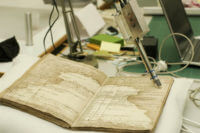Controversies Surrounding Bligh’s Bounty Logbooks Resurface:
Consistent with findings in Conspiracy on the Bounty a commission to examine and conserve Bligh’s surviving logbooks failed to demonstrate that one of them was the original journal that Bligh had penned. The official position of the State Library of New South Wales (where the journal is held) “is that it was written by Bligh during his voyages on the Bounty and on the launch”. This is not correct. Bligh admitted he had copied this particular volume from his ‘original journal’ but the manuscript’s custodians choose not to acknowledge nor publisize this fact. *
In an entirely new twist it is now disclosed that this facsimile copied copy has had various pages removed and replaced with a hotchpotch of watermarked paper, ‘sewn and pasted text-block additions’, into the volume. No prize for guessing that tampered with pages coincide with the very day of the mutiny, and in the words of the conservators, perhaps replaced by Bligh himself. In addition to the substituted folios, tiny particles of hematite, as volcanic material found on beaches near a volcano, were found in the gutters of this particular volume. Microscopic hematite granules were also found in the iron gall ink Bligh used, but only on dates corresponding to a period well after Bligh had landed at Kupang and travelled to Jakarta, not previously when he was sailing westward towards Timor.
Crucial evidence pertaining to the Bounty expedition are two out of a set of three original logbooks. The ‘Conspiracy’ discloses how the middle volume went missing in highly suspicious circumstances, and that the third volume, now held in the SLNSW Mitchell Library and said to be an original, is actually a sanitized copy of the original, which also disappeared.
So is Bligh’s facsimile copied copy a faithful representation of the original? The answer is no, it is not. In order to gloss over extensive failures with the breadfruit, and also to omit entries that may have linked Bligh with orchestrating dissent, it was necessary for Bligh to personally rewrite the volume from 5 April till 21 August 1789.
When it comes to Bligh’s Bounty logbooks historians have had to rely upon formal Admiralty official fair-copies, as very little original material remains to work with. It is significant that very few writers have brought this matter to the attention of their readers. Such a huge gap in primary material would have the effect of devaluing any findings, a fact not easy for Bounty Industry beneficiaries to admit. A commonality that runs through accounts about the mutiny is that they have obligingly focused upon journals that were written up well after the events took place. The great bulk of records of proceedings have been inscribed with ample time to check back and review, or to misrepresent events and proceedings.
* First touted in 1933 by Henderson, G. C. The Discoverers of the Fiji Islands – Tasman, Cook, Bligh, Wilson, Bellingshausen. John Murray, London.
On the forensics of Bligh’s logbooks see online: “From Mutiny to Eternity: The Conservation of Lt. William Bligh’s Bounty Logbooks”
(Picture shows Captain Cook’s logbook being similarly examined with an X-ray Spectrometer. See Online PDF: http://jepspectro.com/img/X-ray-spectrometer/Cookb.jpg)



Administrator’s Note:
While articles are being added to this newly developed News section, public commentary is switched off. If you wish to comment please proceed to Facebook: HMS Bounty – Conspiracy on the Bounty where you will locate an identical or verisimilar article.
See: https://web.facebook.com/HMS-Bounty-Conspiracy-on-the-Bounty-328458497262836/